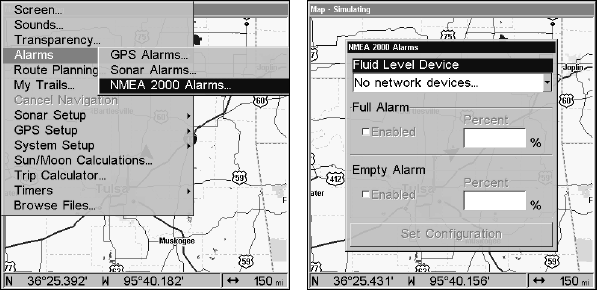
142
IMPORTANT ALARM NOTES
Anchor Alarm - The anchor alarm may be triggered even when
you're sitting still. This can happen when using a small (less than
.05 mile) anchor alarm range.
Arrival Alarm - If you set the arrival alarm's distance to a small
number and you run a route (see the Navigate Routes segment),
this unit may not show navigation data to the next waypoint, once
you arrive at the first one. You may not be able to come close
enough to the first waypoint to trip the arrival alarm.
NMEA 2000 Alarm
The NMEA 2000 Alarm can be set to monitor multiple EP-10 Fuel Flow
and EP-15 Fluid Level sensors. You can set a threshold for each alarm
in its corresponding Percent box. Thresholds give you control over when
the alarm will go off. You may want the alarm to go off when the black
water tank is filled to 75 percent of its capacity, likewise, you may want
to know when the fuel level falls below 30 percent of tank capacity.
To get to the NMEA 2000 Alarms menu, press
MENU|MENU, select
ALARMS and press ENT. Choose NMEA 2000 ALARMS and press ENT.
NMEA 2000 Alarms selected (left). NMEA 2000 Alarms menu (right).
1. With the Fluid Level Device window highlighted, press ENT and use
↑ ↓ to select the device you want to monitor, then press
ENT.
2. To enable the Full Alarm, highlight
FULL ALARM Enabled box and
press
ENT to turn on (check) the alarm. Press → to the Percent box and
press
ENT. Use the ↑ ↓ keys to select the first number, then press → to
move to the next number. When the desired percentage has been en-
tered, press
ENT.
3. To enable the Empty Alarm, highlight the
EMPTY ALARM Enabled box
and press
ENT to turn on (check) the alarm. Press → to the Percent box


















